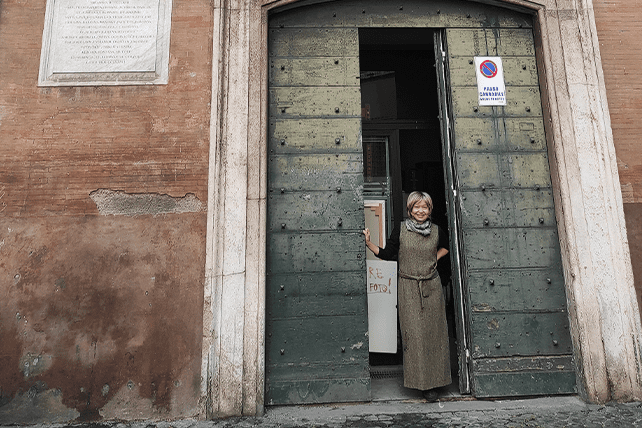According to Moynihan, Tsarkova’s desire to repair the tense relations between the smallest and the largest states in the world was evident early on and continues to be relevant today.
“The events of recent years, and now the war in Ukraine, have made clear that deep, ancestral tensions and suspicions are extraordinarily difficult to overcome, but I still believe Natalia’s exceptional work in Rome will be seen in years to come as a contribution, born from the hope that animated her in the 1990s and early 2000s, to deeper understanding between the East and West, and, eventually, friendship and peace,” he said.
Her most recent isn’t Tsarkova’s first portrait of Benedict, who shocked the world when he became the first to step down as pontiff in over 500 years, but she is the only artist who has been allowed to paint the pope since his retirement. Unlike previous iterations, depicting Benedict as an immovable monolith of Catholic doctrine and morality, her latest is a more dynamic and intimate, though still powerful, portrait of the pope in the sunset of his life.
“It’s a painting that requires contemplation,” Benedict told Tsarkova when he was presented with the final result and asked that it be exhibited in a museum.
In the painting, Benedict is seated among his family members and friends, aging yet smiling, bathed in the loving gaze of those who have stayed beside him — including his ginger tabby cat. Most of the cast surrounding him are women, the Memores Domini, tasked with taking care of the emeritus pope. His caregiver Carmela is portrayed sowing buttons, according to the Russian saying that sewing buttons can grant wishes. The cook, Loredana, holds a tiny menu symbolizing Benedict’s light eating habits. Rosella and Cristina take care of the household chores and the upkeep of the small chapel, which is shown glowing in heavenly light in the upper corner of the canvas.
A reflection in a glass carafe in the foreground shows the pope playing the piano, a beloved hobby of his.
Georg Gänswein, the pope’s personal secretary, is seen transcribing Benedict’s words. “The pope is speaking to us, like he wants to get up and talk to us,” Tsarkova said.
The pope’s brother, Georg Ratzinger, is shown leaning familiarly toward Benedict in the painting, “listening with joy, as if (Benedict’s) words are warming his heart and he is illuminated from within,” Tsarkova explained; she had a chance to sketch Ratzinger’s likeness when he visited the Vatican before his death in 2020.
“I would have this painting made just to be close with my brother,” the pope said after seeing the painting, according to Tsarkova.
Tsarkova, who usually inserts herself in her major commissions, used her own likeness for the Archangel Michael, who is portrayed offering a collection of Benedict’s writings. Since the painting was made while Tsarkova was in isolation during the COVID-19 pandemic, she took a selfie for inspiration.
“I was alone within four walls,” she said. From her window she could see the Vatican as she worked on the portrait of Benedict. “He kept me company. I would wake up and say, ‘Good morning, Holy Father!’ and ‘Good night!’ before falling asleep.” Her owl, of course, never left her side while feeding on quail eggs and baby chicks.
A quick look at the studio points to her love for large compositions. The Last Supper, showing Christ sharply turned toward the viewer and questioning who will betray him, is a massive 7 by 5 feet. St. George defeating a dragon spewing toxic waste and smog looms largely from behind plastic wrapping in the corner of the studio.
On Dec. 1, the painting of Benedict was presented at the Vatican during an award ceremony for the annual Ratzinger Prize awards, handed out to extraordinary contributors in the field of theology. Barbara Jatta, whom Pope Francis appointed to be the first woman to direct the Vatican Museums, praised Tsarkova for her ability “to combine her extraordinary technique with her incredible and original command of composition.”
Tsarkova made five portraits of John Paul II, one of John Paul I, three of Benedict XVI and one of Francis. But for the artist, each is different “in the way they carry the cross, they evangelize and spread the word.”
According to Bethany Bromwell, curator of the St. John Paul II National Shrine in Washington, D.C., Tsarkova offers “educational paintings as well as works of art.” Of all the papal portraits kept at the shrine, Bromwell’s favorite are the ones by Tsarkova, because “they depict stories.”
The shrine holds a large collection of objects and regalia connected to the life and legacy of John Paul II. A number of Tsarkova’s artworks are exhibited there, including portraits of John Paul II and Benedict XVI.

